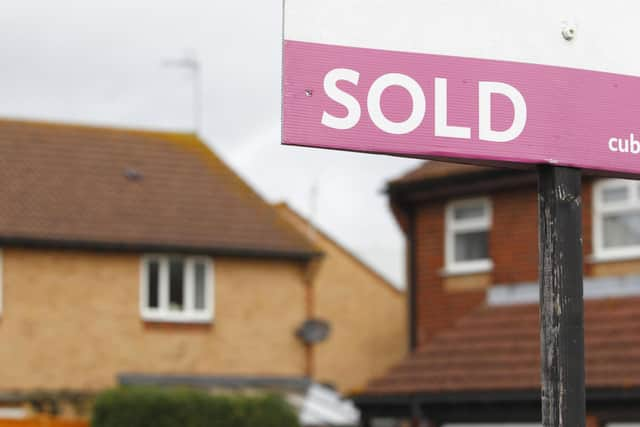Stamp duty holiday: when does the SDLT break end, 2021 rates and how much land tax will I pay after deadline?
This article contains affiliate links. We may earn a small commission on items purchased through this article, but that does not affect our editorial judgement.
and live on Freeview channel 276
House buyers are rushing to complete property moves as the house stamp duty land tax deadline approaches.
The stamp duty holiday was first introduced in June 2020 to encourage property market activity which had taken a hit by the first lockdown in response to the Covid pandemic.
Advertisement
Hide AdAdvertisement
Hide AdThe tax break suspends the cost of stamp duty on the first £500,000 of all property sales - up from £125,000 before the incentive was announced by chancellor Rishi Sunak.


Here’s all you need to know about the stamp duty holiday extension.
What is the stamp duty holiday?
Following months of uncertainty, the housing market was given a boost when Mr Sunak announced a suspension of stamp duty on all property sales up to half-a-million pounds.
The land tax holiday came into effect from 8 July 2020 to help would-be buyers who might have taken a financial hit during the pandemic and encouraged others to move up their time scales.
Advertisement
Hide AdAdvertisement
Hide AdStamp duty is a one-off tax buyers have to pay the government when they purchase a piece of property or land, though it has varied rates and goes by different names in Scotland and Wales.
The threshold at which buyers start paying tax on a new property was increased to £500,000 in England and Northern Ireland and £250,000 in Wales and Scotland until 31 March 2021.
When does the stamp duty holiday end?
Amid further uncertainty over completion dates, Mr Sunak announced that the government was extending the stamp duty holiday in England and Northern Ireland to 30 June 2021.
After this date it will be tapered so that buyers won’t have to pay stamp duty on the first £250,000 of the value of a property, before the tax break ends on 30 September 2021.
Advertisement
Hide AdAdvertisement
Hide AdThe stamp duty holiday only applies to completed property purchases before this date, with normal rates coming into effect once again from the beginning of October 2021.
In Wales, the land transaction tax break on the first £250,000 of a property runs until 30 June 2021 before normal stamp duty rates apply from July 2021.
Ministers in Scotland ended the land and buildings transaction tax holiday for properties bought north of the border on 31 March 2021, where pre-pandemic rates apply again.
How much is stamp duty in England and Northern Ireland?
Stamp duty rates during the holiday period up to 30 June 2021:
- Up to £500,000 - Zero
- The next £425,000 (the portion from £500,001 to £925,000) - 5%
- The next £575,000 (the portion from £925,001 to £1.5 million) - 10%
- The remaining amount (the portion above £1.5 million) - 12%
Advertisement
Hide AdAdvertisement
Hide AdFrom 1 July 2021 to 30 September 2021, the following rates apply:
- Up to £250,000 - Zero
- The next £675,000 (the portion from £250,001 to £925,000) - 5%
- The next £575,000 (the portion from £925,001 to £1.5 million) - 10%
- The remaining amount (the portion above £1.5 million) - 12%
Rates from 1 October 2021 return to pre-8 July 2020 levels:
- Up to £125,000 - Zero
- The next £125,000 (the portion from £125,001 to £250,000) - 2%
- The next £675,000 (the portion from £250,001 to £925,000) - 5%
- The next £575,000 (the portion from £925,001 to £1.5 million) - 10%
- The remaining amount (the portion above £1.5 million) - 12%
How much do first time buyers pay in stamp duty?
First time buyers will not pay any stamp duty on the first £300,000 of a property purchase from 1 July 2021, which was the case before the holiday came into effect.
What are the normal land transaction tax rates in Wales?
From 1 July 2021 people buying property in Wales will pay:
- £180,001-£250,000 - 3.5%
- £250,001-£400,000 - 5%
- £400,001-£750,000 - 7.5%
- £750,001-£1.5m - 10%
- Above £1.5m - 12%
What are the land and building transaction tax rates in Scotland?
The normal rates of tax are:
- £145,001-£250,000 - 2%
- £250,001-£325,000 - 5%
- £325,001-£750,000 - 10%
- Above £750,000 - 12%
A message from the editor:
Thank you for reading. NationalWorld is a new national news brand, produced by a team of journalists, editors, video producers and designers who live and work across the UK. Find out more about who’s who in the team, and our editorial values. We want to start a community among our readers, so please follow us on Facebook, Twitter and Instagram, and keep the conversation going. You can also sign up to our email newsletters and get a curated selection of our best reads to your inbox every day.
Comment Guidelines
National World encourages reader discussion on our stories. User feedback, insights and back-and-forth exchanges add a rich layer of context to reporting. Please review our Community Guidelines before commenting.